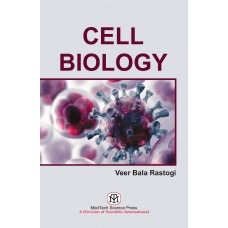1. Introduction to Cell Biology 1–11
Introduction.........................................................................................................................
Discovery of Cell ................................................................................................................
Emergence of Modern Cell Biology..................................................................................
Cytology and Other Biological Sciences ..........................................................................
2. Organization of Cell .................................................................
Introduction.......................................................................................................................
History of Cell....................................................................................................................
Cell Theory.........................................................................................................................
Cell as a Self-Contained or Autonomous Body.............................................................
Cellular Totipotency..........................................................................................................
Diversity in Size and Shape of Cells................................................................................
Types of Cells.....................................................................................................................
1. Prokaryotic Cells or Prokaryons Bacterial Cell, Cynobacteria,
Pleuropneumonia-like Organism .........................................................................
2. Eukaryotic Cells or Eukaryons...............................................................................
Viruses : An Exception to Cell Structure .......................................................................
Viroids and Prions.............................................................................................................
3. Chemistry of Living Matter—The Protoplasm.........................
Protoplasm ........................................................................................................................
Cellular Pool......................................................................................................................
Biomolecules......................................................................................................................
I. Water.........................................................................................................................
II. Inorganic Substances.............................................................................................
III. Organic Molecules..................................................................................................
1. Carbohydrates..............................................................................................................
2. Lipids...............................................................................................................................
Contents
3. Proteins...........................................................................................................................
4. Nucleic Acids .................................................................................................................
Watson and Crick’s Model of DNA (Molecular Structure of DNA).......................
5. Ribonucleic Acid (RNA)..............................................................................................
6. Enzymes..........................................................................................................................
Holoenzymes and Apoenzymes..................................................................................
Isozymes.........................................................................................................................
7. Vitamins .........................................................................................................................
Regulatory Substances.................................................................................................
Prostaglandins..............................................................................................................
4. Cell Membrane..............................
Biomembranes...................................................................................................................
Ultrastructure of Biomembranes.....................................................................................
Significance of Biomembranes.....................................................................................
Plasma Membrane...........................................................................................................
Ultrastructure...................................................................................................................
Chemical Composition...................................................................................................
Evolution of Molecular Structure (Models of Plasma Membrane)...........................
Fluid Mosaic Model of Plasma Membrane ..................................................................
Membrane Asymmetry...................................................................................................
Fluidity of Plasma Membrane.......................................................................................
Cell Coat....................................................................................................................
Biogenesis or Origin of Plasma Membrane .................................................................
Functions of Plasma Membrane....................................................................................
5. Membrane Functions: Cell Adhesion and Cell Junctions......
Cell Adhesion Molecules (CAMS) Cadherins, Integrins, Selectins
Immunoglobulins............................................................................................................
Cell Junctions...................................................................................................................
Desmosomes or Macula Adherens ..............................................................................
Belt Desomosomes or Zonula Adherens, Tight Junctions........................................
or Zonula Occuludens Gap Junctions (Nexus) ...........................................................
6. Transport Across Cell Membrane.........................................
Permeability and transport ............................................................................................
Transport Across Plasma Membrane.........................................................................
1. Osmosis .......................................................................................................................
2. Passive Transport.........................................................................................................
Diffusion, Facilitated Diffusion.................................................................................
3. Active Transport.........................................................................................................
4. Transport of Ions........................................................................................................
5. Transport of Large Molecules....................................................................................
viii Contents
7. Cell Walls...............................................................................
Cell Walls..........................................................................................................................
Bacterial Cell Wall...........................................................................................................
Fungal Cell Wall ..............................................................................................................
Plant Cell Wall .................................................................................................................
Functions of Cell Wall.....................................................................................................
8. Cytoskeleton..........................................................................
Cytoskeleton.....................................................................................................................
1. Microfilaments.............................................................................................................
2. Intermediate Filaments (IFs).....................................................................................
3. Microtubules ...............................................................................................................
Motor Proteins or Molecular Motors......................................................................
9. Cell Signaling ........................................................................
Steps of Cell Signaling.....................................................................................................
Significance of Cell Signaling........................................................................................
Modes of Cell Signaling..................................................................................................
Signaling Molecules ........................................................................................................
Cell Surface Receptors....................................................................................................
Pathways of Intracellular Signal Transduction............................................................
10. Endomembrane System ........................................................
Endoplasmic Reticulum (ER)........................................................................................
Annulate Lamellae...........................................................................................................
Inter-relations of the Cell Membranes..........................................................................
Microsomes......................................................................................................................
11. Golgi Complex ......................................................................
History ..............................................................................................................................
Occurrence of Golgi Complex.......................................................................................
Morphology of Golgi Complex .....................................................................................
Membrane Flow in Golgi Complex...............................................................................
Membrane Recycling ......................................................................................................
Origin of Golgi Complex..............................................................................................
Functions of Golgi Complex..........................................................................................
12. Microbodies : Lysosomes, Peroxisomes and Glyoxisomes.....
Lysosomes (The Suicide Bags of Cell)...........................................................................
Peroxisomes......................................................................................................................
Glyoxysomes....................................................................................................................
Lysosomes in Plants
Spherosomes, Aleurone Grains, Vacuoles....................................................................
Contents ix
13. Vesicular Transport...............................................................
Vesicular Transport.....................................................................................................
Endocytic and Secretory Pathways...............................................................................
Protein Sorting and Vesicular Traffic from ER to Golgi.............................................
Transport from Trans Golgi Network........................................................................
Types of Secretory Pathways..........................................................................................
14. Cellular Energy Transections ...............................................
Cell and Energy ...........................................................................................................
Exergonic and Endergonic Reactions..........................................................................
Concept of Free Energy ..................................................................................................
Energy Flow and Laws of Thermodynamics................................................................
Energy Transformation in Living Systems.................................................................
Adensosine Triphosphate ...............................................................................................
15. Mitochondria ........................................................................
Ultrastructure of Mitochondria.....................................................................................
Electron Transport System (ETS) or Respiratory Chain............................................
Mitochondrial DNA........................................................................................................
Mitochondrial RNA......................................................................................................
Ribosomes and Protein Synthesis in Mitochondria....................................................
Semiautonomous Nature of Mictochondria (Symbiont Hypothesis).......................
Biogenesis of Mitochondria ...........................................................................................
Degeneration of Mitochondria......................................................................................
Functions of Mitochondria ............................................................................................
16. Cellular Respiration and Energy Production.....................
Cellular Respiration ........................................................................................................
Respiratory Substrate .....................................................................................................
Types of Cellular Respiration.........................................................................................
Mechanism of Respiration ..........................................................................................
Oxidation of Extramitochondrial NADH .................................................................
Some Other Pathways of Glucose Metabolism ...........................................................
Differences Between EMP, PPP and ED Pathways .....................................................
Glyoxylate Cycle .............................................................................................................
17. Plastids ................................................................................
Classification of Plastids.................................................................................................
Origin and Development of Plastids.............................................................................
Functions of Plastids.......................................................................................................
Chloroplasts .....................................................................................................................
The Photosynthetic Apparatus.......................................................................................
Mechanism of Photosynthesis.......................................................................................
Necessity of Two Photosystems...................................................................................
x Contents
Other Pathways of Fixation............................................................................................
Chloroplasts as Semiautonomous Organoids..............................................................
Symbiotic Origin of Chloroplasts..................................................................................
18. Ribosomes.............................................................................
Ultrastructure of Ribosomes.......................................................................................
Mitochondrial and Chloroplast Ribosomes, Ribosomal Proteins............................
Biogenesis of Ribosomes .............................................................................................
19. Centriole and Cell Centre .....................................................
Ultrastructure...................................................................................................................
Associated Structures of Centrioles..............................................................................
Chemical Composition of Centrioles
Functions........................................................................................................................
20. Extra-Cellular Structures......................................................
Cilia, Flagella and Basal Bodies.....................................................................................
Ultrastructure...................................................................................................................
Basal Bodies ..................................................................................................................
21. Interphase Nucleus...............................................................
Structure of Interphase Nucleus....................................................................................
1. Nuclear Envelope.........................................................................................................
2. Nucleoplasm or Nuclear Matrix................................................................................
3. Nucleolus......................................................................................................................
4. Chromatin or Nuclear Recticulum ..........................................................................
Euchromatin and Heterochromatin .......................................................................
22. Chromosomes .......................................................................
What are Chromosomes?...............................................................................................
Viral Chromosomes........................................................................................................
Prokaryotic Genome.......................................................................................................
Mitochondrial Chromosome.........................................................................................
ukaryotic Chromosomes...........................................................................................
Different Regions Recognized in Chromosomes........................................................
Molecular Organisation of Chromosomes...................................................................
Special Types of Chromosomes:....................................................................................
1. Lampbrush Chromosomes.........................................................................................
2. Polytene Chromosomes..............................................................................................
Physiology of Chromosomes.....................................................................................
23. Cell Division..........................................................................
Cell Cycle .........................................................................................................................
Check Points in Cell Cycle ...........................................................................................
Maturation Promoting Factor (MPF)...........................................................................
Cell Division.....................................................................................................................
Contents xi
1. Amitosis......................................................................................................................
2. Mitosis...........................................................................................................................
Energetics of Cell Division.........................................................................................
Meiosis........................................................................................................................
I. Heterotypic Division (Reduction Division)........................................................
II. Homeotypic Division............................................................................................
Salient Features of Meiosis ....................................................................................
Synapsis in Chromosomes.....................................................................................
24. Cell Growth, Cellular Ageing or Senescence and Cell Death
Cell Growth......................................................................................................................
Growth in Unicellular Organisms.................................................................................
Growth in Multicellular Organisms..............................................................................
Mechanism of Cell Growth.........................................................................................
Cell Types Based on Different Growth Patterns.........................................................
Cellular Ageing or Senescence.......................................................................................
Pace of Cellular Ageing...................................................................................................
Changes During Ageing .................................................................................................
Theories to Explain Cell Senescence.............................................................................
Regulation of Size of Cell................................................................................................
25. Cancer....................................................................................
What is Cancer?...............................................................................................................
Types of Cancers .............................................................................................................
Characteristics of Malignant Tumours .....................................................................
Characteristics of Cancer Cells...................................................................................
Causes of Carcinogenesis...............................................................................................
Theories of Caroinogenesis............................................................................................
26. Microscopy ............................................................................
Tools to Study Biology ....................................................................................................
Microscopy.......................................................................................................................
Light Microscope.............................................................................................................
Phase Constrast Microscope .........................................................................................
Differential Interference Microscopy............................................................................
Polarisation Microscope ................................................................................................
Ultraviolet Microscope ...................................................................................................
Fluorescent Microscopy...............................................................................................
Spectrophotometry .........................................................................................................
Electron Microscope .......................................................................................................
Principle
Types
Working of TEM
xii Contents
Working of SEM
Preparation of Material for Electron Microscope
X-Ray Diffraction Microscopy : Special Features .......................................................
27. Cytochemical Techniques.....................................................
Cytological Study of Preserved Cells............................................................................
Fixation.............................................................................................................................
Embedding .......................................................................................................................
Sectioning.........................................................................................................................
Staining ..........................................................................................................................
Morphological and Cytochemical Stains .....................................................................
28. Cell Separation and Cell Fractionation by
Centrifugation Flow Cytometry ...........................................
Cell Fractionation............................................................................................................
Tissue Homogenisation..................................................................................................
Centrifugation..................................................................................................................
Density Gradient Centrifugation ..................................................................................
Types of Centrifugation..................................................................................................
Ultracentrifugation..........................................................................................................
Centrifugal Elutriation .................................................................................................
Flow Cytometry...............................................................................................................
29. Molecular Separation by Chromatography..........................
Chromatography..........................................................................................................
Principle of Chromatography .......................................................................................
Applications of Chromatography..................................................................................
Types of Chromatography..............................................................................................
Column Chromatography..............................................................................................
Partition Chromatography............................................................................................
Paper Chromatography ..................................................................................................
Gas Chromatography......................................................................................................
Thin Layer Chromatography..........................................................................................
Gel Filtration Chromatography.....................................................................................
Ion Exchange Chromatography............................................................................






